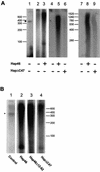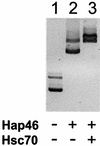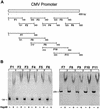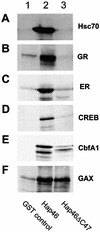Transcriptional stimulation by the DNA binding protein Hap46/BAG-1M involves hsp70/hsc70 molecular chaperones
- PMID: 12682371
- PMCID: PMC153731
- DOI: 10.1093/nar/gkg303
Transcriptional stimulation by the DNA binding protein Hap46/BAG-1M involves hsp70/hsc70 molecular chaperones
Abstract
The hsp70/hsc70-associating protein Hap46 of human origin, also called BAG-1M (Bcl-2-associated athanogene 1), has been characterized previously as a DNA binding protein, which is able to stimulate transcription. By use of in vitro assays we now show that Hap46-mediated transcriptional activation can occur from linearized as well as from supercoiled circular DNA and does not require the presence of a transcription promoter. Accordingly, we observed no preferential binding of Hap46 to overlapping DNA fragments covering the sequence of the cytomegalovirus (CMV) early promoter, thus suggesting non-specific binding. The C-terminal deletion variant Hap46DeltaC47, which is unable to associate with hsp70/hsc70 molecular chaperones, produced greatly diminished effects on transcription, indicating a significant involvement of hsp70/hsc70 chaperones but not an absolute requirement. In contrast, deletion of the acidic hexarepeat region, as in variant Hap46Delta12-62, did not disturb transcriptional stimulation. While full-length Hap46 readily formed complexes with a series of structurally unrelated transcription factors, variant Hap46DeltaC47 proved incapable of doing so. Together these data suggest that transcriptional stimulation is a major biological activity of Hap46 and point to involvement of hsp70/hsc70 molecular chaperones in transcription in concert with Hap46, thus providing a link between hsp70/hsc70 molecular chaperones and components of the transcription machinery.
Figures






Similar articles
-
Biological activities of HAP46/BAG-1. The HAP46/BAG-1 protein: regulator of HSP70 chaperones, DNA-binding protein and stimulator of transcription.EMBO Rep. 2004 Feb;5(2):148-53. doi: 10.1038/sj.embor.7400083. EMBO Rep. 2004. PMID: 14755308 Free PMC article. Review.
-
The hsp70-associating protein Hap46 binds to DNA and stimulates transcription.Proc Natl Acad Sci U S A. 1999 Aug 31;96(18):10194-9. doi: 10.1073/pnas.96.18.10194. Proc Natl Acad Sci U S A. 1999. PMID: 10468585 Free PMC article.
-
Multiple biological activities of the mammalian protein Hap46/BAG-1.Arzneimittelforschung. 2005;55(6):344-52. doi: 10.1055/s-0031-1296870. Arzneimittelforschung. 2005. PMID: 16032975
-
Multiple, but concerted cellular activities of the human protein Hap46/BAG-1M and isoforms.Int J Mol Sci. 2009 Mar;10(3):906-928. doi: 10.3390/ijms10030906. Epub 2009 Mar 2. Int J Mol Sci. 2009. PMID: 19399228 Free PMC article. Review.
-
Dissection of the ATP-binding domain of the chaperone hsc70 for interaction with the cofactor Hap46.J Biol Chem. 2001 Mar 30;276(13):10178-84. doi: 10.1074/jbc.M006967200. Epub 2000 Dec 19. J Biol Chem. 2001. PMID: 11121403
Cited by
-
Stress proteins: the biological functions in virus infection, present and challenges for target-based antiviral drug development.Signal Transduct Target Ther. 2020 Jul 13;5(1):125. doi: 10.1038/s41392-020-00233-4. Signal Transduct Target Ther. 2020. PMID: 32661235 Free PMC article. Review.
-
Virus-heat shock protein interaction and a novel axis for innate antiviral immunity.Cells. 2012 Sep 11;1(3):646-66. doi: 10.3390/cells1030646. Cells. 2012. PMID: 24710494 Free PMC article.
-
Biological activities of HAP46/BAG-1. The HAP46/BAG-1 protein: regulator of HSP70 chaperones, DNA-binding protein and stimulator of transcription.EMBO Rep. 2004 Feb;5(2):148-53. doi: 10.1038/sj.embor.7400083. EMBO Rep. 2004. PMID: 14755308 Free PMC article. Review.
-
Cell-Free Protein Synthesis: Pros and Cons of Prokaryotic and Eukaryotic Systems.Chembiochem. 2015 Nov;16(17):2420-31. doi: 10.1002/cbic.201500340. Epub 2015 Oct 19. Chembiochem. 2015. PMID: 26478227 Free PMC article. Review.
-
Activities of the cochaperones Hap46/BAG-1M and Hap50/BAG-1L and isoforms.Cell Stress Chaperones. 2006 Winter;11(4):295-303. doi: 10.1379/1466-1268(2006)11[295:aotcba]2.0.co;2. Cell Stress Chaperones. 2006. PMID: 17278878 Free PMC article. Review.
References
-
- Takayama S., Sato,T., Krajewski,S., Kochel,K., Irie,S., Millan,J.A. and Reed,J.C. (1995) Cloning and functional analysis of BAG-1: a novel Bcl-2-binding protein with anti-cell death activity. Cell, 80, 279–284. - PubMed
Publication types
MeSH terms
Substances
LinkOut - more resources
Full Text Sources
Miscellaneous

